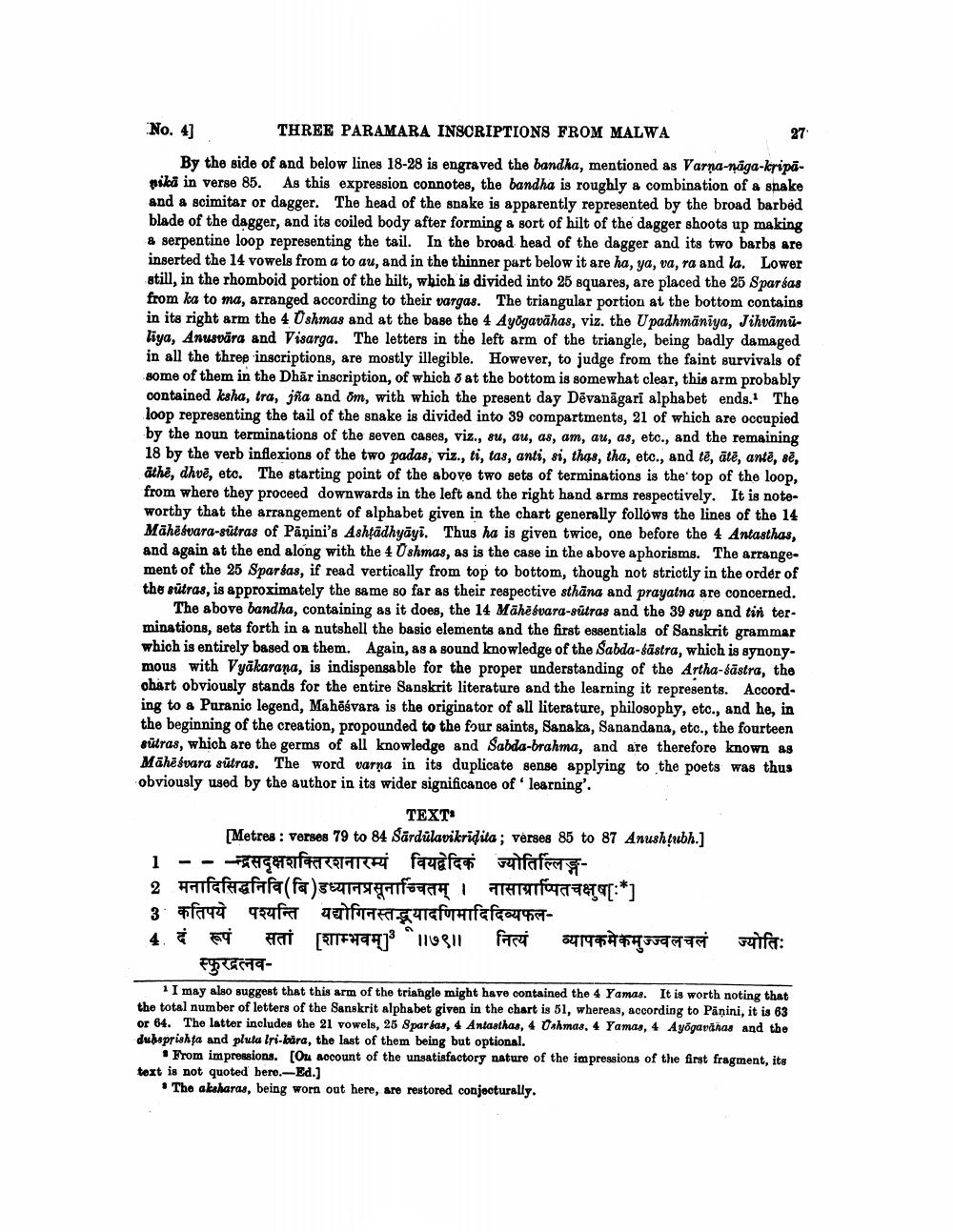________________
No. 4]
THREE PARAMARA INSCRIPTIONS FROM MALWA By the side of and below lines 18-28 is engraved the bandha, mentioned as Varna-nāga-kripāpika in verse 85. As this expression connotes, the bandha is roughly a combination of a snake and a scimitar or dagger. The head of the snake is apparently represented by the broad barbed blade of the dagger, and its coiled body after forming & sort of hilt of the dagger shoots up making & serpentine loop representing the tail. In the broad head of the dagger and its two barbs are inserted the 14 vowels from a to au, and in the thinner part below it are ha, ya, va, ra and la. Lower still, in the rhomboid portion of the hilt, which is divided into 25 squares, are placed the 25 Sparsas from ka to ma, arranged according to their vargas. The triangular portion at the bottom contains in its right arm the 4 Ushmas and at the base the 4 Ayogavāhas, viz. the Upadhmaniya, Jihvāmuliya, Anusvāra and Visarga. The letters in the left arm of the triangle, being badly damaged in all the three inscriptions, are mostly illegible. However, to judge from the faint survivals of some of them in the Dhār inscription, of which o at the bottom is somewhat clear, this arm probably oontained ksha, tra, jña and om, with which the present day Dēvanāgari alphabet ends. The loop representing the tail of the snake is divided into 39 compartments, 21 of which are occupied by the noun terminations of the seven cases, viz., su, au, as, am, au, as, etc., and the remaining 18 by the verb inflexions of the two padas, viz., ti, tas, anti, si, thas, tha, etc., and tē, ātē, antë, sē, äthe, dhvē, etc. The starting point of the above two sets of terminations is the top of the loop, from where they proceed downwards in the left and the right hand arms respectively. It is noteworthy that the arrangement of alphabet given in the chart generally follows the lines of the 14 Mähèsvara-sutras of Pāņini's Ashțādhyāyi. Thus ha is given twice, one before the 4 Antasthas, and again at the end along with the 4 Oshmas, as is the case in the above aphorisms. The arrangement of the 25 Sparsas, if read vertically from top to bottom, though not strictly in the order of the sütras, is approximately the same so far as their respective sthāna and prayatna are concerned.
The above bandha, containing as it does, the 14 Māhësvara-sūtras and the 39 sup and tin terminations, sets forth in a nutshell the basic elements and the first essentials of Sanskrit grammar which is entirely based on them. Again, as a sound knowledge of the Sabda-sästra, which is synonymous with Vyakarana, is indispensable for the proper understanding of the Artha-śāstra, the obart obviously stands for the entire Sanskrit literature and the learning it represents. Accord ing to a Puranic legend, Mahēšvara is the originator of all literature, philosophy, etc., and he, in the beginning of the creation, propounded to the four saints, Sanaka, Sanandana, etc., the fourteen sütras, which are the germs of all knowledge and Sabda-brahma, and are therefore known as Mähê svara sütras. The word varna in its duplicate sense applying to the poets was thus obviously used by the author in its wider significance of learning'.
TEXT: [Metres : verses 79 to 84 Sārdülavikridita ; verses 85 to 87 Anushçubh.] 1 -- garfactarei fayafaa wulfafen2 fafaefiffa(fa)
g a cy I hat
* 3 कतिपये पश्यन्ति यद्योगिनस्तद्भयादणिमादिदिव्यफल4. दं रूपं सतां [शाम्भवम् ॥७९॥ नित्यं व्यापकमेकमुज्ज्वलचलं ज्योतिः
स्फुरद्रत्नव1 I may also suggest that this arm of the triangle might have contained the 4 Yamas. It is worth noting that the total number of letters of the Sanskrit alphabet given in the chart is 51, whereas, according to Pāņini, it is 63 or 64. The latter includes the 21 vowels, 25 Sparkas, 4 Antasthas, 4 Oshmas, 4 Yamas, 4 Ayōgarahas and the duboprishta and pluta Iri-lara, the last of them being but optional.
From impressions. [Ou account of the unsatisfactory nature of the impressions of the first fragment, its text is not quoted bero.-Ed.)
The akaharas, being worn out here, are restored conjecturally,




